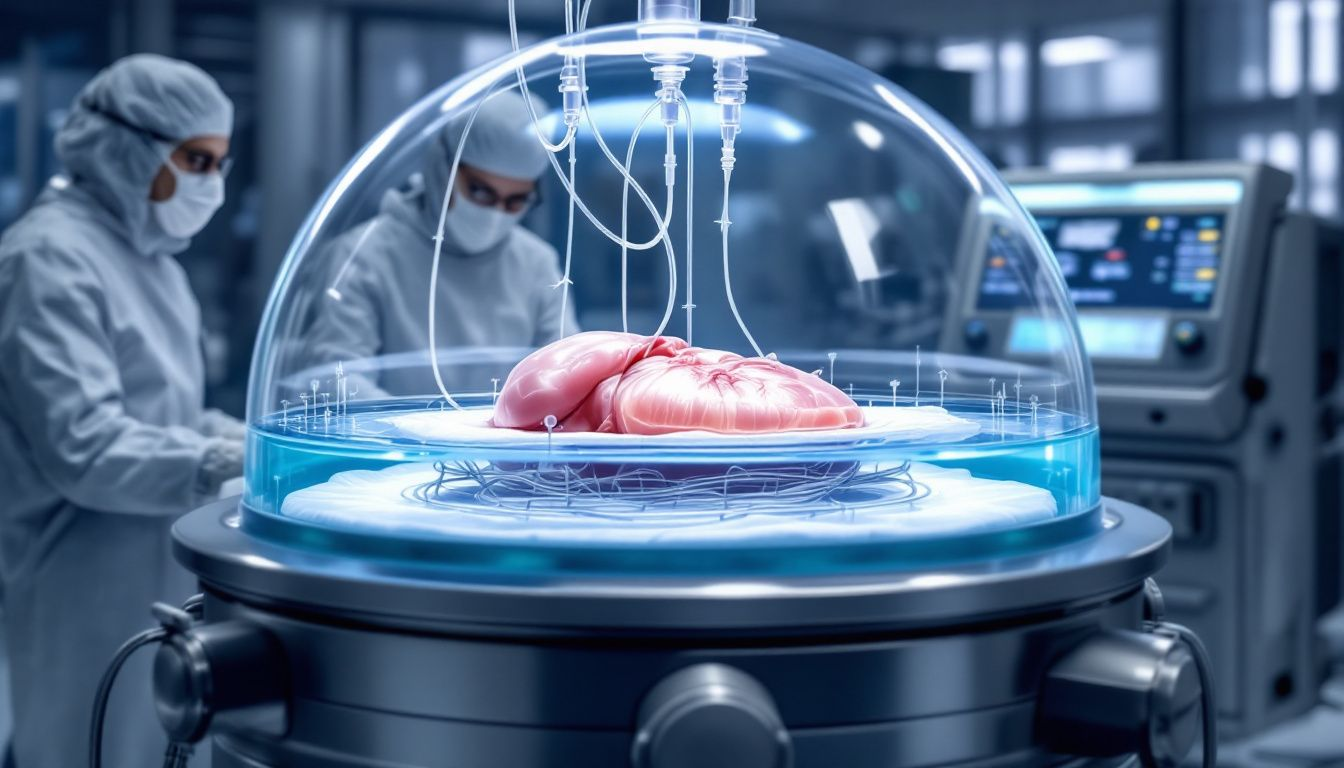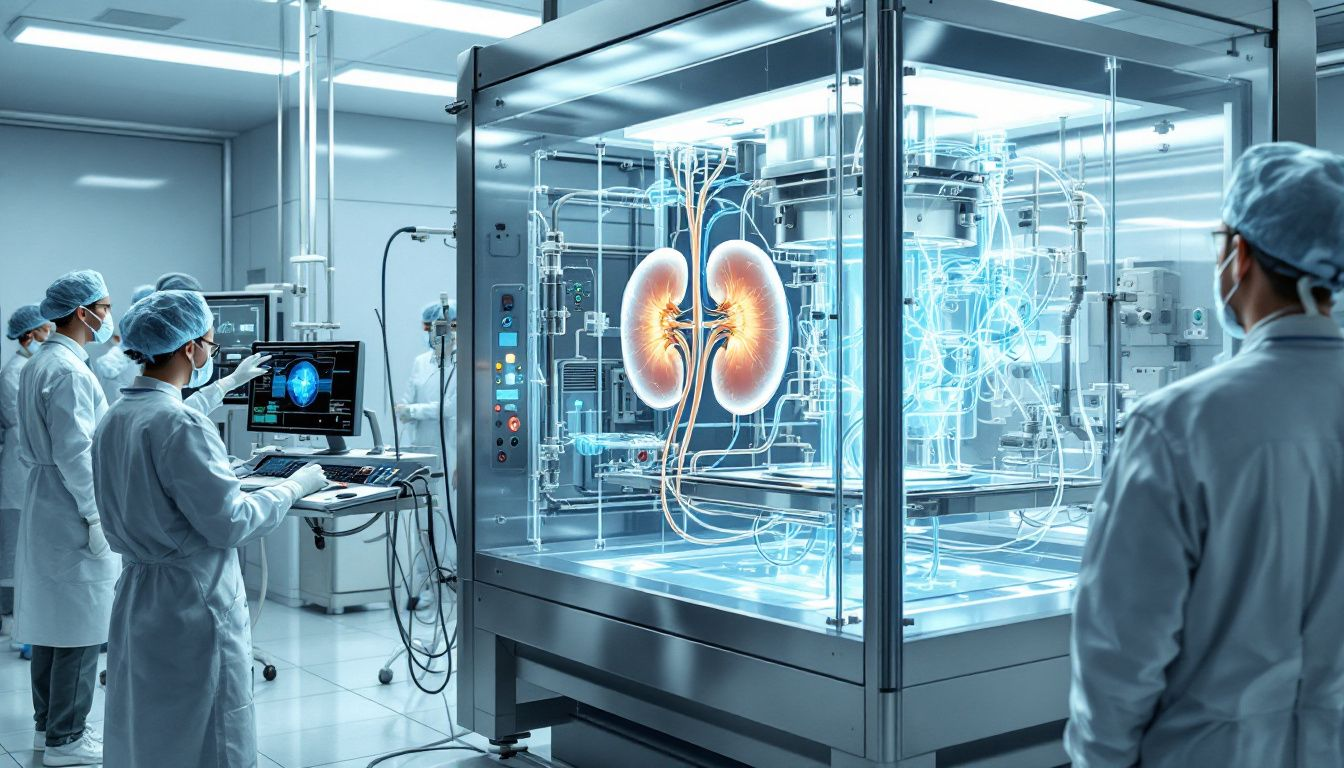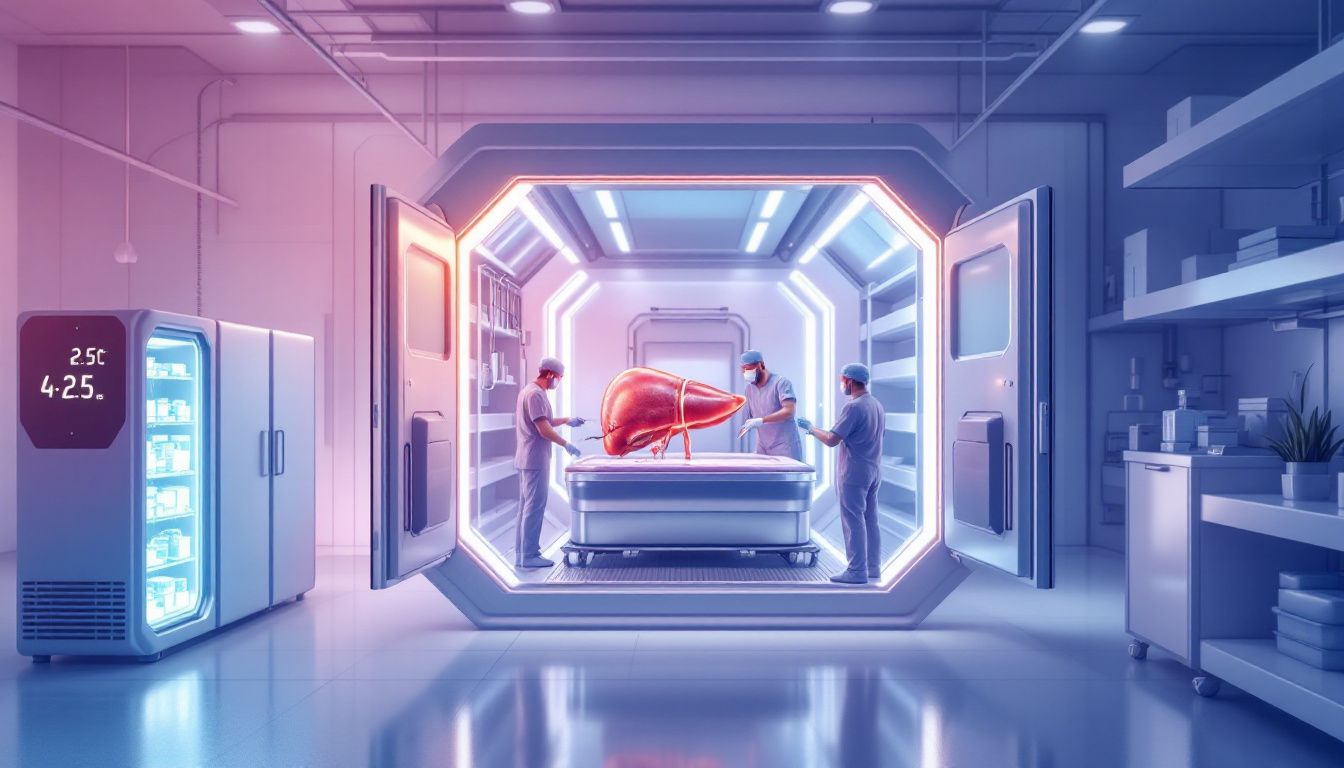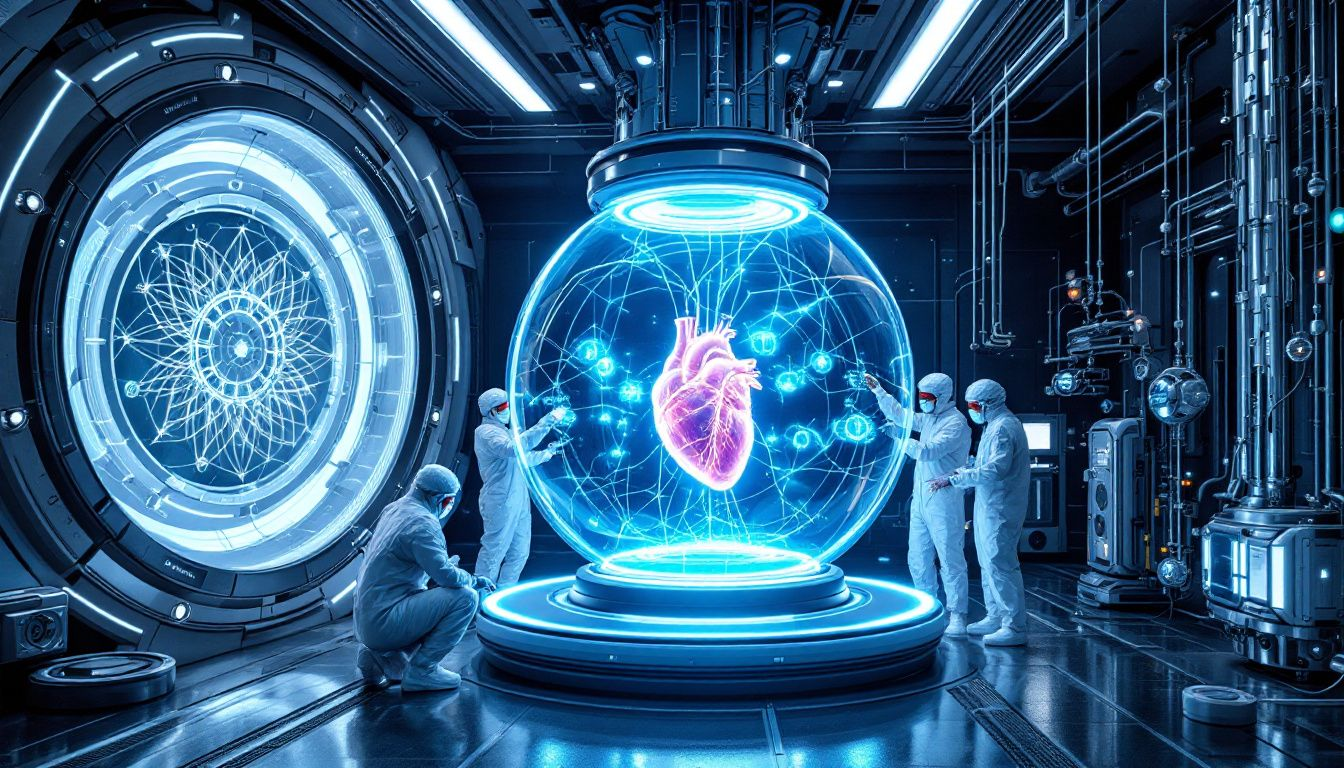Top Organ Preservation Techniques During Transport: Best Practices and Innovations
Ensuring organs stay viable during transport is vital for successful transplants. This article covers essential organ preservation techniques during transport, including cold storage, machine perfusion, and emerging innovations. Learn about each method’s efficacy, benefits, and limitations.
Key Takeaways
Static cold storage (SCS) remains a foundational organ preservation method but is limited to few hours of viability during transport.
Hypothermic Machine Perfusion (HMP) enhances organ preservation compared to SCS by providing continuous perfusion and reducing ischemic injury, with recent innovations like oxygenated hypothermic perfusion (HOPE) further improving outcomes.
Normothermic Machine Perfusion (NMP) allows for real-time functional assessments and metabolic activity of organs during transport, representing a significant advancement in preservation techniques.
Static Cold Storage (SCS)
Static cold storage (SCS) stands as the cornerstone of organ preservation, a method that has been the standard bearer for decades. The rationale behind SCS is straightforward yet profoundly effective: by reducing the temperature of the organ, metabolic processes are significantly slowed, thereby preserving cellular integrity and prolonging viability. This method is indispensable during the critical window between organ removal and transplantation, ensuring that organs remain viable during organ transport despite the cessation of blood flow and oxygen supply.
The primary mechanism of SCS involves flushing the organ with a cold preservation solution, followed by storage on ice. This hypothermic preservation technique is designed to reduce cellular metabolism and thereby extend the organ’s viability during transport. However, while effective, SCS typically allows for preservation times of only a few hours, which can be a significant limitation when dealing with longer transport durations.
A key factor in the success of SCS is the choice of cold preservation solution. These solutions are formulated to stabilize cellular structures and combat acidosis, critical in maintaining organ viability. Despite its limitations, SCS remains a vital tool in the organ preservation arsenal, particularly for its simplicity and reliability.
Different organs have varying requirements, and this specificity must be addressed to ensure the highest possible success rates in transplantation. While SCS has its constraints, ongoing research and improvements in preservation solutions continue to enhance its efficacy, making it a dependable method in the organ preservation toolkit.
Preservation Solutions
The efficacy of static cold storage hinges significantly on the quality of the preservation solutions used. Among these, the University of Wisconsin (UW) solution is widely regarded as the gold standard, known for its complex formulation that includes antioxidants like glutathione, allopurinol, and hydroxyethyl starch. These components work synergistically to reduce cellular edema and oxidative damage, thereby improving storage outcomes.
Another commonly used solution is the Histidine-tryptophan-ketoglutarate (HTK) solution, particularly favored for abdominal organ preservation. HTK’s low viscosity and unique buffering properties make it ideal for maintaining the viability of organs such as the liver and pancreas during transport. Similarly, the Celsior solution is designed to minimize cellular swelling while providing robust antioxidant protection, with reduced glutathione as a key ingredient.
Preservation solutions are not one-size-fits-all; they are meticulously formulated to address the specific needs of different organs and preservation techniques used when organs are transported by air. For example, kidney preservation often utilizes solutions like UW and HTK, while liver preservation may benefit from the use of Celsior. These solutions contain impermeants and buffers that stabilize cellular structures and combat acidosis, crucial for maintaining organ viability during transport.
Ongoing research in organ preservation solutions aims to further refine these formulations, enhancing their ability to protect organs during hypothermic machine preservation and other advanced techniques. The goal is to extend preservation times and improve outcomes for transplant recipients, ensuring that each precious donation has the best possible chance of success.
Hypothermic Machine Perfusion (HMP)

Hypothermic Machine Perfusion (HMP) represents a significant advancement over static cold storage, offering continuous perfusion of cold preservation solution through the organ at low pressure. Operating at temperatures between 2°C and 8°C, HMP provides a controlled environment that maintains cellular metabolism at a minimal level while supplying oxygen and nutrients, and removing metabolic waste.
The benefits of HMP are notable. HMP maintains microvasculature tone and continuous perfusion, reducing the risk of ischemic injury and improving transplant outcomes. The UW solution, modified for machine perfusion, is a common choice, optimized to support the specific needs of the perfusion process. Additionally, hydroxyethyl starch is included in these solutions to prevent cellular edema, further enhancing organ preservation.
HMP is particularly advantageous for kidney preservation, significantly improving renal function post-transplant. Recent innovations also explore the potential of hypothermic oxygenated perfusion (HOPE) and sub-normothermic temperatures to further optimize the preservation process. These advancements underscore the versatility and effectiveness of HMP in extending the viability of donor organs.
Oxygenated Hypothermic Perfusion
The integration of oxygen into hypothermic machine perfusion, known as oxygenated hypothermic machine perfusion (HOPE), offers enhanced protection against ischemic injury. Oxygenated perfusion supports ATP synthesis, which is crucial for cellular energy and function, thereby reducing oxidative stress and improving organ viability. This technique is particularly beneficial for kidneys, aiding in their recovery after ischemic injury and enhancing transplant outcomes.
During HOPE, viability assessments are performed by measuring flow and resistance parameters and analyzing biomarkers such as glutathione S-transferase and lactate dehydrogenase. These assessments provide critical insights into the organ’s condition, ensuring only viable organs are transplanted. Furthermore, ongoing research is exploring the supplementation of perfusion solutions with red blood cells and other substitutes to extend perfusion times and improve outcomes.
The benefits of oxygenation during machine perfusion are also being studied for liver preservation, showing promise in reducing ischemic injury and enhancing post-transplant function. Combining cooling with oxygenation in HOPE further exemplifies the innovative strides being made in organ preservation techniques.
Normothermic Machine Perfusion (NMP)
Normothermic Machine Perfusion (NMP) has emerged as a groundbreaking technique, offering significant advantages in organ preservation. Unlike hypothermic methods, NMP maintains organs at normal body temperature, which supports aerobic metabolism and restores cellular function. This approach minimizes cold ischemia injury and allows for a comprehensive functional assessment of the organ during transport.
One of the key benefits of NMP is the ability to keep organs metabolically active, which promotes recovery and repair during transport. This is particularly beneficial for liver preservation, where maintaining hepatic function is crucial for successful transplantation. However, the restoration of cellular function can also potentially upregulate inflammatory mediators, which needs careful monitoring to avoid causing harm.
NMP systems typically use glucose as an energy source in the perfusate, ensuring that the organ’s metabolic needs are met during transport. Additionally, the combination therapy of Controlled Oxygenated Rewarming (COR) is being explored, transitioning from SCS or HMP to NMP to gently prepare the graft for transplant. This method offers a simpler protocol, potentially reduces costs, and minimizes the risk of pump failure.
Overall, NMP represents a significant leap forward in organ preservation, combining the benefits of normothermic conditions with the ability to perform real-time functional assessments, thus enhancing the success rates of transplants.
Functional Assessment During Transport
Normothermic Machine Perfusion (NMP) allows for a full functional assessment of organs during transport, a capability that static cold storage lacks. NMP supports ongoing metabolic activity by maintaining organs at body temperature, enabling real-time viability assessment. This is particularly crucial for kidney preservation, where NMP is the primary technique for evaluating graft function before transplantation.
Biomarkers such as glutathione S-transferase and lactate dehydrogenase are used during NMP to provide critical insights into the quality and viability of the preserved organs. These assessments ensure that only organs with the highest potential for successful transplantation are selected, thereby improving overall outcomes and reducing the risk of graft failure.
Did you know that you can get from Manhattan to JFK in under 5 minutes without driving?
Blade offers seamless helicopter transfers from our West 30th Street Lounge in Manhattan to JFK Airport in just 5 minutes from $195 per seat.
Skip the traffic and ditch the stress with Blade's year-round airport service.

Sub-normothermic Machine Perfusion (SNMP)

Sub-normothermic Machine Perfusion (SNMP), operating at temperatures below normal body temperature but above hypothermic levels, typically around 21°C, presents a unique approach to organ preservation. This technique aims to balance the benefits of reduced metabolic demand with the advantages of maintaining some cellular activity. The reduced temperature in SNMP potentially offers cytoprotective effects, enhancing the viability of organs during transport.
Preclinical studies have shown promising results, indicating that sub-normothermic preservation can maintain hepatocellular and biliary function for several hours in discarded livers. This technique not only extends preservation times but also improves the quality of the organs, making them more suitable for liver transplantation.
The ongoing research in SNMP continues to explore its potential in preserving various organ types, paving the way for broader clinical application.
Subzero Organ Preservation

Subzero organ preservation is a cutting-edge technique that aims to extend the viability of organs beyond the capabilities of traditional methods. A critical challenge in this approach is managing ice formation, which can cause severe cellular damage and disrupt overall tissue structure. Innovative methods are being developed to address this issue, including the use of preservation solutions and modified sugars to prevent ice formation.
Supercooling, a process that keeps organs at subzero temperatures without freezing, has shown promise in extending preservation times significantly. Studies have demonstrated that organs can remain viable for up to four days at temperatures around -6°C, far surpassing the few hours achievable with traditional cold storage. This technique offers a revolutionary approach to organ preservation, potentially transforming the logistics of organ transport.
Isochoric preservation, which uses pressure to fine-tune preservation conditions, is another innovative method being explored. This technique allows for precise control over temperature and pressure, enhancing organ viability and opening new avenues for preservation. Additionally, insights from organisms that naturally prevent ice formation are being applied to develop antifreeze proteins for organ preservation.
The advancements in subzero preservation techniques hold great promise for the future of organ transplantation, offering the potential for longer preservation times and improved outcomes for transplant recipients.
Ischemia-Reperfusion Injury Mitigation
Ischemia-reperfusion injury is a significant challenge in organ transplantation, impacting the viability and function of the transplanted organs. This injury occurs when blood supply returns to the organ after a period of ischemia or lack of oxygen, leading to inflammation and oxidative damage. Mitigating this injury is crucial for improving transplant outcomes.
Ex vivo machine perfusion offers a significant advancement over standard preservation methods by allowing real-time monitoring of organ quality and potentially reducing ischemia-reperfusion injury. Enhanced flow conditions during ex vivo perfusion can significantly affect the metabolic state of the organ, influencing its recovery and function post-transplant. Ex vivo perfusion systems provide a controlled environment that mirrors physiological conditions, minimizing the risk of injury during the transition from hypothermic to normothermic states.
One promising method for reducing ischemia-reperfusion injury is controlled oxygenated rewarming (COR). This technique is being studied as a way to gently transition organs from hypothermic to normothermic states, reducing the stress associated with temperature changes and improving organ viability. These advancements highlight the importance of continuous innovation in organ preservation to address the challenges of ischemia-reperfusion injury effectively.
Advances in Ex Vivo Perfusion Systems
The field of ex vivo perfusion systems is rapidly evolving, offering new possibilities for organ preservation and transplantation. These systems create a more natural environment for the organ, maintaining physiological conditions that support cellular metabolism and function. This approach not only preserves organ viability but also allows for innovative organ repair strategies.
Current research on perfusion solutions focuses on optimizing their composition to support cellular metabolism and organ viability during preservation. By fine-tuning the components of these solutions, researchers aim to enhance the effectiveness of ex vivo perfusion systems, potentially leading to better transplant outcomes. The concept of organ regeneration through ex vivo machine perfusion is also emerging as a promising avenue for future research, offering the potential to repair and rejuvenate organs before transplantation.
One of the most exciting developments in ex vivo perfusion is the potential for organ engineering. The first success in whole organ engineering was reported using ex vivo machine perfusion, demonstrating the feasibility of this approach. Although many challenges remain, the continued exploration of organ engineering could revolutionize the field of transplantation, providing new options for patients in need of life-saving transplants.
Ex vivo perfusion systems are crucial for enhancing organ preservation, offering a controlled environment that mirrors physiological conditions. As research continues to advance, these systems hold the promise of transforming the landscape of organ transplantation, making it possible to preserve and even improve the quality of donor organs.
Did you know that you can get from Manhattan to JFK in under 5 minutes without driving?
Blade offers seamless helicopter transfers from our West 30th Street Lounge in Manhattan to JFK Airport in just 5 minutes from $195 per seat.
Skip the traffic and ditch the stress with Blade's year-round airport service.

Organ-Specific Preservation Techniques
Organ-specific preservation techniques are essential for addressing the unique preservation needs of each organ type during transport. Different organs have varying physiological requirements, and tailoring preservation methods to these needs can significantly enhance the viability and function of the organs. Ex vivo perfusion systems can be customized for various organs, with specific designs that address the unique challenges associated with each type.
For example, heart and lung preservation techniques focus on minimizing ischemic time and optimizing perfusion solutions to ensure successful transplantation. Similarly, kidneys and livers require specific preservation solutions and techniques to maintain their viability during transport.
Understanding and addressing these unique needs allows organ-specific preservation techniques to improve transplantation outcomes and increase donor organ usability.
Kidney Preservation
Kidney preservation techniques have evolved significantly over the years, with traditional methods relying on hypothermia to reduce metabolic activities during transportation. Static cold storage remains a common practice, using solutions like the Euro-Collins solution to maintain organ viability. However, modern techniques such as Hypothermic Machine Perfusion (HMP) have shown considerable benefits in enhancing kidney preservation.
HMP maintains higher ATP levels compared to static cold storage, resulting in better kidney function post-transplant. Studies have shown that HMP reduces the incidence of delayed graft function (DGF) in deceased donor kidneys, improving overall transplant outcomes. Despite this, some studies indicate no significant difference in graft survival at one year between HMP and static cold storage, highlighting the need for further research.
Innovations in kidney preservation include portable HMP systems like the LifePort Kidney Transporter and the WAVES machine, which showcase significant advancements in the field. Additionally, devices such as the Kidney Assist by Organ Assist and the OrganOx prototype demonstrate new methods for portable kidney preservation under normothermic conditions, offering promising results for extended preservation times and immediate graft function post-transplant.
Research continues to improve kidney preservation techniques, potentially enhancing long-term outcomes for transplant recipients. Exploring new methods and refining existing ones aims to increase kidney transplantation success rates and ensure better patient outcomes.
Liver Preservation
Liver preservation techniques are crucial for maintaining hepatic function and reducing biliary complications during transplantation. Traditional methods often involve static cold storage using preservation solutions like UW, HTK, and Celsior. However, advancements in machine perfusion techniques have shown significant promise in extending liver preservation times and improving outcomes.
Sub-normothermic machine perfusion (SNMP) can extend the preservation time of liver grafts up to 27 hours without impacting organ viability. This technique balances reduced metabolic demand with the benefits of maintaining some cellular activity, enhancing the quality of the preserved liver. Additionally, using a defatting protocol during SNMP can significantly lower triglyceride levels in steatotic livers, improving their suitability for transplantation.
Combining supercooling with SNMP shows promise in preserving liver function and structure during prolonged storage. These innovative techniques represent significant advancements in liver preservation, offering the potential to improve transplant outcomes and increase the usability of donor livers.
Heart and Lung Preservation
Heart and lung preservation techniques focus on minimizing ischemic injury and optimizing preservation solutions to ensure successful transplantation. Proper cooling and the choice of preservation solution are critical for maintaining the viability of these organs during transport. For lung preservation, low potassium solutions are often used to prevent edema and maintain function.
The HTK solution is commonly used for both heart and lung preservation due to its reduced viscosity and low potassium, sodium, and magnesium concentrations. This solution provides an effective balance of components, making it beneficial for maintaining organ viability during transport. For cardiac preservation, a hyperkalemic, crystalloid cardioplegia solution is utilized to protect the heart during storage.
The generally accepted limit of cold ischemia for cardiac preservation is 4 hours, while for lung preservation, it is 6 hours. These time constraints highlight the importance of efficient and effective preservation techniques to ensure the success of heart and lung transplants. Ongoing research continues to refine these methods, aiming to extend preservation times and improve outcomes.
By understanding and addressing the unique requirements of heart and lung preservation, medical professionals can enhance the success rates of these critical transplants, ensuring that patients receive the best possible care.
Ethical Considerations in Organ Transport
The ethical considerations in organ transport are as crucial as the technical aspects of preservation. The principle of respect for persons emphasizes the importance of honoring individual autonomy in organ donation decisions. This means that the wishes of both donors and recipients must be respected, ensuring that the process is conducted with the highest ethical standards.
Beneficence in organ allocation requires balancing potential benefits against possible harms for both donors and recipients. This involves careful consideration of medical need and urgency, ensuring that organs are allocated to those who will benefit most from the transplant. Fairness in organ distribution is also paramount, ensuring that similar cases are treated similarly and that the process is transparent and equitable.
Trustworthiness is essential in organ donation and transplantation, requiring transparency in the processes involved and emphasizing the role of air transport in organ donation. Public trust in organ allocation is crucial, as perceptions of unfairness can deter individuals from registering as organ donors.
Types of organ donors include extended criteria donors (ECDs), deceased donors after circulatory death (DCDs), and donation after circulatory death (DBDs). Each type of extended criteria donor presents unique ethical considerations that must be addressed to ensure the integrity of the organ donation process.
Adhering to these ethical principles helps maintain public trust and ensures that organ transplantation is conducted with the highest standards of care and respect.
Future Directions in Organ Preservation

The future of organ preservation is poised for transformative advancements, with emerging technologies and innovative approaches promising to revolutionize the field. Cryopreservation is expected to make true organ banking practical, allowing organs to be stored at extremely low temperatures, such as -160°C. Vitrification, a process that stores organs in a glass-like amorphous state, reduces ice-related damage and enhances the viability of preserved organs.
Ex vivo machine perfusion may become the clinical standard, offering the potential for innovative therapies beyond traditional organ transplantation. This approach allows for the real-time monitoring and repair of organs before transplantation, improving their quality and increasing the success rates of transplants. The first success in whole organ engineering using ex vivo machine perfusion has already been reported, highlighting the potential of this technique.
Xenotransplantation, the transplantation of organs from one species to another, is becoming a focus of interest as a potential solution to the shortage of human donor organs. This approach, combined with advancements in organ engineering, could significantly expand the availability of organs for transplantation.
Ongoing research continues to explore new methods and refine existing ones, promising longer storage times and the recovery of marginal donor organs. The influence of decades of scientific exploration has shaped current practices in organ perfusion and preservation, paving the way for future innovations.
As research continues to advance, the future of organ preservation looks bright, offering the potential for longer storage times, improved outcomes, and the ability to meet the growing demand for organ transplants.
Bottom Line:Top Organ Preservation Techniques During Transport: Best Practices and Innovations
In summary, the field of organ preservation has made significant strides, offering a range of techniques and innovations that enhance the viability and function of donor organs during transport. From the traditional method of static cold storage (SCS) to the advanced approaches of hypothermic machine perfusion (HMP), normothermic machine perfusion (NMP), and sub-normothermic machine perfusion (SNMP), each technique offers unique benefits and challenges.
Innovations in preservation solutions and subzero organ preservation techniques further extend the viability of organs, while ethical considerations ensure that the process is conducted with the highest standards of care and respect. The future of organ preservation looks promising, with emerging technologies such as cryopreservation, ex vivo machine perfusion, and xenotransplantation offering new possibilities for extending the shelf life of organs and meeting the growing demand for transplants.
As we continue to explore and refine these techniques, the ultimate goal remains the same: to save lives and improve outcomes for transplant recipients. The relentless pursuit of excellence in organ preservation is a testament to the dedication and ingenuity of medical professionals and researchers, ensuring that each precious donation has the best possible chance of success.
FAQs about Top Organ Preservation Techniques During Transport
What is static cold storage (SCS)?
Static cold storage (SCS) is a method used for organ preservation that reduces cellular metabolism and prolongs
How does hypothermic machine perfusion (HMP) differ from SCS?
Hypothermic machine perfusion (HMP) improves organ viability by continuously perfusing a cold preservation solution, whereas static cold storage (SCS) simply stores the organ without active circulation. This active process of HMP helps maintain minimal cellular metabolism and facilitates better oxygen and nutrient supply while removing waste.
What are the benefits of normothermic machine perfusion (NMP)?
Normothermic machine perfusion (NMP) offers significant benefits by
What is the role of oxygenated hypothermic machine perfusion (HOPE)?
Oxygenated hypothermic machine perfusion (HOPE) plays a crucial role in enhancing organ preservation by supporting ATP synthesis and reducing oxidative stress, ultimately improving the viability of organs, especially kidneys, through the addition of oxygen in the perfusion process.
What are the future directions in organ preservation?
The future of organ preservation focuses on advancements such as cryopreservation, vitr
Disclaimer:
Please be aware that the content on this page has been generated by using artificial intelligence language models and may contain errors, inconsistencies, or outdated information. It is provided as-is without any warranties or guarantees of accuracy. We strongly recommend using this content as a starting point for further research. We disclaim any liability for damages or losses resulting from the use or reliance on this content.